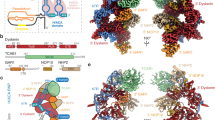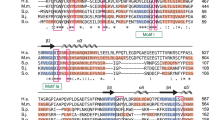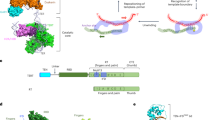Abstract
Box H/ACA ribonucleoprotein particles (RNPs) catalyze RNA pseudouridylation and direct processing of ribosomal RNA, and are essential architectural components of vertebrate telomerases. H/ACA RNPs comprise four proteins and a multihelical RNA. Two proteins, Cbf5 and Nop10, suffice for basal enzymatic activity in an archaeal in vitro system. We now report their cocrystal structure at 1.95-Å resolution. We find that archaeal Cbf5 can assemble with yeast Nop10 and with human telomerase RNA, consistent with the high sequence identity of the RNP components between archaea and eukarya. Thus, the Cbf5–Nop10 architecture is phylogenetically conserved. The structure shows how Nop10 buttresses the active site of Cbf5, and it reveals two basic troughs that bidirectionally extend the active site cleft. Mutagenesis results implicate an adjacent basic patch in RNA binding. This tripartite RNA-binding surface may function as a molecular bracket that organizes the multihelical H/ACA and telomerase RNAs.
This is a preview of subscription content, access via your institution
Access options
Subscribe to this journal
Receive 12 print issues and online access
$189.00 per year
only $15.75 per issue
Buy this article
- Purchase on Springer Link
- Instant access to full article PDF
Prices may be subject to local taxes which are calculated during checkout





Similar content being viewed by others
References
Meier, U.T. The many facets of H/ACA ribonucleoproteins. Chromosoma 114, 1–14 (2005).
Ganot, P., Bortolin, M-L. & Kiss, T. Site-specific pseudouridine formation in preribosomal RNA is guided by small nucleolar RNAs. Cell 89, 799–809 (1997).
Ni, J., Tien, A.L. & Fournier, M.J. Small nucleolar RNAs direct site-specific synthesis of pseudouridine in ribosomal RNA. Cell 89, 565–573 (1997).
Rozhdestvensky, T.S. et al. Binding of L7Ae protein to the K-turn of archaeal snoRNAs: a shared RNA binding motif for C/D and H/ACA box snoRNAs in archaea. Nucleic Acids Res. 31, 869–877 (2003).
Tang, T.H. et al. Identification of 86 candidates for small non-messenger RNAs from the archaeon Archaeoglobus fulgidus. Proc. Natl Acad. Sci. USA 99, 7536–7541 (2002).
Watkins, N.J. et al. Cbf5p, a potential pseudouridine synthase, and Nhp2p, a putative RNA-binding protein, are present together with Gar1p in all H BOX/ACA-motif snoRNPs and constitute a common bipartite structure. RNA 4, 1549–1568 (1998).
Lafontaine, D.L.J., Bousquet-Antonelli, C., Henry, Y., Caizergues-Ferrer, M. & Tollervey, D. The box H+ACA snoRNAs carry Cbf5p, the putative rRNA pseudouridine synthase. Genes Dev. 12, 527–537 (1998).
Lubben, B., Fabrizio, P., Kastner, B. & Luhrmann, R. Isolation and characterization of the small nucleolar ribonucleoprotein particle snR30 from Saccharomyces cerevisiae. J. Biol. Chem. 270, 11549–11554 (1995).
Bousquet-Antonelli, C., Henry, Y., Gélugne, J.P., Caizergues-Ferrer, M. & Kiss, T. A small nucleolar RNP protein is required for pseudouridylation of eukaryotic ribosomal RNAs. EMBO J. 16, 4770–4776 (1997).
Henras, A. et al. Nhp2p and Nop10p are essential for the function of H/ACA snoRNPs. EMBO J. 17, 7078–7090 (1998).
Klein, D.J., Schmeing, T.M., Moore, P.B. & Steitz, T.A. The kink-turn: a new RNA secondary structure motif. EMBO J. 20, 4214–4221 (2001).
Hamma, T. & Ferré-D'Amaré, A.R. Structure of protein L7Ae bound to a K-turn derived from an archaeal box H/ACA sRNA at 1.8 Å resolution. Structure (Camb) 12, 893–903 (2004).
Girard, J.P. et al. GAR1 is an essential small nucleolar RNP protein required for pre-rRNA processing in yeast. EMBO J. 11, 673–682 (1992).
Wang, C. & Meier, U.T. Architecture and assembly of mammalian H/ACA small nucleolar and telomerase ribonucleoproteins. EMBO J. 23, 1857–1867 (2004).
Baker, D.L. et al. RNA-guided RNA modification: functional organization of the archaeal H/ACA RNP. Genes Dev. 19, 1238–1248 (2005).
Charpentier, B., Muller, S. & Branlant, C. Reconstitution of archaeal H/ACA small ribonucleoprotein complexes active in pseudouridylation. Nucleic Acids Res. 33, 3133–3144 (2005).
Henras, A.K., Capeyrou, R., Henry, Y. & Caizergues-Ferrer, M. Cbf5p, the putative pseudouridine synthase of H/ACA-type snoRNPs, can form a complex with Gar1p and Nop10p in absence of Nhp2p and box H/ACA snoRNAs. RNA 10, 1704–1712 (2004).
Koonin, E.V. Pseudouridine synthases: four families of enzymes containing a putative uridine-binding motif also conserved in dUTPases and dCTP deaminases. Nucleic Acids Res. 24, 2411–2415 (1996).
Aravind, L. & Koonin, E.V. Novel predicted RNA-binding domains associated with the translation machinery. J. Mol. Evol. 48, 291–302 (1999).
Hoang, C. & Ferré-D'Amaré, A.R. Cocrystal structure of a tRNA Ψ55 pseudouridine synthase: nucleotide flipping by an RNA-modifying enzyme. Cell 107, 929–939 (2001).
Zebarjadian, Y., King, T., Fournier, M.J., Clarke, L. & Carbon, J. Point mutations in yeast CBF5 can abolish in vivo pseudouridylation of rRNA. Mol. Cell. Biol. 19, 7461–7472 (1999).
Morrissey, J.P. & Tollervey, D. Yeast snR30 is a small nucleolar RNA required for 18S rRNA synthesis. Mol. Cell. Biol. 13, 2469–2477 (1993).
Atzorn, V., Fragapane, P. & Kiss, T. U17/snR30 is a ubiquitous snoRNA with two conserved sequence motifs essential for 18S rRNA production. Mol. Cell. Biol. 24, 1769–1778 (2004).
Bally, M., Hughes, J. & Cesareni, G. SnR30: a new, essential small nuclear RNA from Saccharomyces cerevisiae. Nucleic Acids Res. 16, 5291–5303 (1988).
Mitchell, J.R., Cheng, J. & Collins, K. A box H/ACA small nucleolar RNA-like domain at the human telomerase RNA 3′ end. Mol. Cell. Biol. 19, 567–576 (1999).
Dez, C. et al. Stable expression in yeast of the mature form of human telomerase RNA depends on its association with the box H/ACA small nucleolar RNP proteins Cbf5p, Nhp2p and Nop10p. Nucleic Acids Res. 29, 598–603 (2001).
Heiss, N.S. et al. X-linked dyskeratosis congenita is caused by mutations in a highly conserved gene with putative nucleolar functions. Nat. Genet. 19, 32–38 (1998).
Vulliamy, T. et al. The RNA component of telomerase is mutated in autosomal dominant dyskeratosis congenita. Nature 413, 432–435 (2001).
Marrone, A., Walne, A. & Dokal, I. Dyskeratosis congenita: telomerase, telomeres and anticipation. Curr. Opin. Genet. Dev. 15, 249–257 (2005).
Ruggero, D. et al. Dyskeratosis congenita and cancer in mice deficient in ribosomal RNA modification. Science 299, 259–262 (2003).
Krishna, S.S., Majumdar, I. & Grishin, N.V. Structural classification of zinc fingers: survey and summary. Nucleic Acids Res. 31, 532–550 (2003).
Holm, L. & Sander, C. Protein structure comparison by alignment of distance matrices. J. Mol. Biol. 233, 123–138 (1993).
Sander, C. & Schneider, R. Database of homology-derived protein structures and structural meaning of sequence alignment. Proteins Struct. Funct. Genet. 9, 56–68 (1991).
Pan, H., Agarwalla, S., Moustakas, D.T., Finer-Moore, J. & Stroud, R.M. Structure of tRNA pseudouridine synthase TruB and its RNA complex: RNA recognition through a combination of rigid docking and induced fit. Proc. Natl Acad. Sci. USA 100, 12648–12653 (2003).
Chaudhuri, B.N., Chan, S., Perry, L.J. & Yeates, T.O. Crystal structure of the apo forms of ψ 55 tRNA pseudouridine synthase from Mycobacterium tuberculosis: a hinge at the base of the catalytic cleft. J. Biol. Chem. 279, 24585–24591 (2004).
Phannachet, K. & Huang, R.H. Conformational change of pseudouridine 55 synthase upon its association with RNA substrate. Nucleic Acids Res. 32, 1422–1429 (2004).
Ferré-D'Amaré, A.R. RNA-modifying enzymes. Curr. Opin. Struct. Biol. 13, 49–55 (2003).
Mueller, E.G. Chips off the old block. Nat. Struct. Biol. 9, 320–322 (2002).
Spedaliere, C.J., Hamilton, C.S. & Mueller, E.G. Functional importance of motif I of pseudouridine synthases: mutagenesis of aligned lysine and proline residues. Biochemistry 39, 9459–9465 (2000).
Dyson, H.J. & Wright, P.E. Intrinsically unstructured proteins and their functions. Nat. Rev. Mol. Cell Biol. 6, 197–208 (2005).
Ishitani, R. et al. Alternative tertiary structure of tRNA for recognition by a posttranscriptional modification enzyme. Cell 113, 383–394 (2003).
Sattler, M., Schleucher, J. & Griesinger, C. Heteronuclear multidimensional NMR experiments for the structure determination of proteins in solution employing pulsed field gradients. Prog. Nucl. Magn. Reson. Spectrosc. 34, 93–158 (1999).
Delaglio, F. et al. NMRPipe: a multidimensional spectral processing system based on UNIX pipes. J. Biomol. NMR 6, 277–293 (1995).
Guntert, P. Automated NMR structure calculation with CYANA. Methods Mol. Biol. 278, 353–378 (2004).
Cornilescu, G., Delaglio, F. & Bax, A. Protein backbone angle restraints from searching a database for chemical shift and sequence homology. J. Biomol. NMR 13, 289–302 (1999).
Laskowski, R.J., Macarthur, M.W., Moss, D.S. & Thornton, J.M. PROCHECK: a program to check stereochemical quality of protein structures. J. Appl. Crystallogr. 26, 283–290 (1993).
Nicholls, A., Bharadwaj, R. & Honig, B. GRASP-graphical representation and analysis of surface properties. Biophys. J. 64, A116–A125 (1993).
Koradi, R., Billeter, M. & Wuthrich, K. MOLMOL: a program for display and analysis of macromolecular structures. J. Mol. Graph. 14, 51–55 (1996).
Carson, M. Ribbons 2.0. J. Appl. Crystallogr. 24, 958–961 (1991).
Otwinowski, Z. & Minor, W. Processing of X-ray diffraction data collected in oscillation mode. Methods Enzymol. 276, 307–326 (1997).
Terwilliger, T.C. & Berendzen, J. Automated MAD and MIR structure solution. Acta Crystallogr. D Biol. Crystallogr. 55, 849–861 (1999).
Brünger, A.T. et al. Crystallography and NMR system: a new software system for macromolecular structure determination. Acta Crystallogr. D Biol. Crystallogr. 54, 905–921 (1998).
Jones, T.A., Zou, J.Y., Cowan, S.W. & Kjeldgaard, M. Improved methods for building protein models in electron density maps and the location of errors in these models. Acta Crystallogr. A 47, 110–119 (1991).
Lovell, S.C. et al. Structure validation by Cα geometry: φ, ψ and Cβ deviation. Proteins 50, 437–450 (2003).
Dragon, F., Pogacic, V. & Filipowicz, W. In vitro assembly of human H/ACA small nucleolar RNPs reveals unique features of U17 and telomerase RNAs. Mol. Cell. Biol. 20, 3037–3048 (2000).
Liu, J.F. et al. Crystal structure of KD93, a novel protein expressed in human hematopoietic stem/progenitor cells. J. Struct. Biol. 148, 370–374 (2004).
Acknowledgements
We thank C. Hoang for experimental contributions to initial stages of this project, A. Roll-Mecak for advice on protein coexpression, J. Bolduc for in-house X-ray support, the staff of Advanced Light Source beamline 5.0.2. for synchrotron data collection support, N. Isern at Pacific Northwest National Laboratories and the staff at the National Magnetic Resonance Facility at Madison for support with NMR data collection, N. Leuliott (IBBMC, Université Paris-Sud) for providing yNop10 expression vector and T. Edwards, K. Godin, D. Klein, J. Pitt, B. Shen, B. Stoddard and H. Xiao for discussions. This work was supported by the US National Institutes of Health (grants to A.R.F. and G.V. and Viral Oncology training grant to T.H.). T.H. is a Leukemia & Lymphoma Society Special Fellow. A.R.F. is a Distinguished Young Scholar in Medical Research of the W.M. Keck Foundation.
Author information
Authors and Affiliations
Corresponding authors
Ethics declarations
Competing interests
The authors declare no competing financial interests.
Supplementary information
Supplementary Fig. 1
Multiple sequence alignment of Nop10. (PDF 183 kb)
Supplementary Fig. 2
Zinc-ribbon domain of free aNop10. (PDF 334 kb)
Supplementary Fig. 3
In vitro reconstitution of an archaeal H/ACA RNP analyzed by the electrophoretic mobility shift assay. (PDF 878 kb)
Supplementary Fig. 4
Multiple sequence alignment of Cbf5/Dyskerin (PDF 384 kb)
Supplementary Fig. 5
Multiple sequence alignment of the PUA domain. (PDF 495 kb)
Supplementary Fig. 6
Molecular surface of the aCbf5–aNop10 complex cocrystal structure and a hypothetical RNA double helix. (PDF 730 kb)
Supplementary Fig. 7
Portion of the 1.95-Å resolution solvent-flattened MAD experimental electron density map contoured at 1.1 standard deviations above mean peak height. (PDF 1675 kb)
Supplementary Table 1
NMR and refinement statistics for aNop10 and yNop10. (DOC 48 kb)
Rights and permissions
About this article
Cite this article
Hamma, T., Reichow, S., Varani, G. et al. The Cbf5–Nop10 complex is a molecular bracket that organizes box H/ACA RNPs. Nat Struct Mol Biol 12, 1101–1107 (2005). https://doi.org/10.1038/nsmb1036
Received:
Accepted:
Published:
Issue Date:
DOI: https://doi.org/10.1038/nsmb1036
This article is cited by
-
Contribution of protein Gar1 to the RNA-guided and RNA-independent rRNA:Ψ-synthase activities of the archaeal Cbf5 protein
Scientific Reports (2018)
-
RNA-dependent pseudouridylation catalyzed by box H/ACA RNPs
Frontiers in Biology (2018)
-
A core-attachment based method to detect protein complexes in PPI networks
BMC Bioinformatics (2009)
-
The coding/non-coding overlapping architecture of the gene encoding the Drosophila pseudouridine synthase
BMC Molecular Biology (2007)
-
Non-coding RNAs: lessons from the small nuclear and small nucleolar RNAs
Nature Reviews Molecular Cell Biology (2007)



